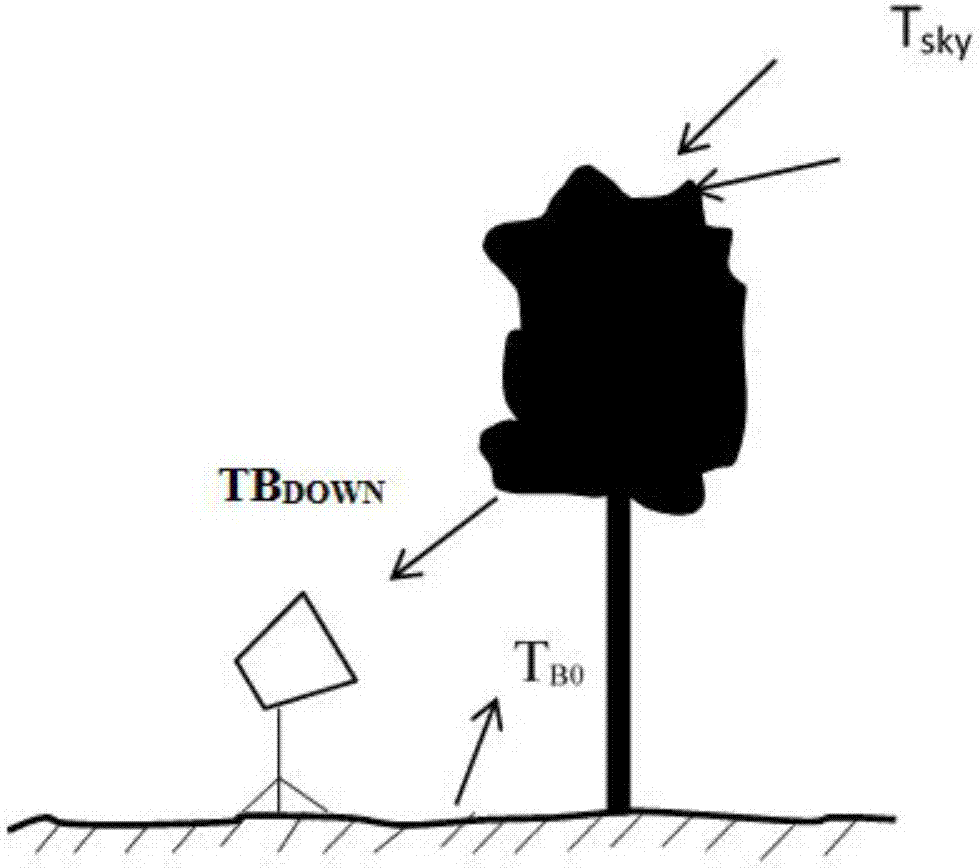Method for optimizing and estimating L-waveband forest microwave radiation transmission characteristics
A technology of microwave radiation and transmission characteristics, applied in the field of forest parameter estimation, can solve the problem of lack of accurate and effective L-band forest microwave radiation transmission
- Summary
- Abstract
- Description
- Claims
- Application Information
AI Technical Summary
Problems solved by technology
Method used
Image
Examples
Embodiment 1
[0054] The optimal estimation method for microwave radiation transmission characteristics of L-band forests is carried out for coniferous forests. The forest parameters are shown in Table 1:
[0055] Step 1, a) Use the L-band microwave radiometer to measure the multi-angle forest downlink microwave radiation brightness temperature TB MEA and the sky downlink microwave radiance temperature T SKY ; b) Simultaneously measure the forest temperature T by the thermal infrared instrument V and soil temperature T S ; c) Measure surface roughness parameters (surface root mean square height and surface correlation length) using roughness plate; d) Measure soil moisture using ring knife sampling method; e) According to parameters such as soil moisture and soil roughness, use AIEM The model simulates the surface emissivity eS;
[0056] Step 2. The simulated L-band forest downlink microwave radiance temperature TB SIM :
[0057] TB SIM =[t×(T SKY -T V )+T V ×(1-r V )+r V × e S ...
Embodiment 2
[0065] For the coniferous forest in Example 1, a spatial location different from that in Example 1 is selected for estimation, and other processes are the same as in Example 1. Optimal estimation of forest effective transmittance t and forest effective scattering albedo ω, the results are as follows figure 2 (b) and 4(b).
[0066] For confirming the correctness and effectiveness of the optimal estimation method of the L-band forest microwave radiation transmission characteristic of the present invention, the forest microwave radiation transmission model simulation of the physical process is carried out to the forest microwave radiation transmission characteristic parameter (t and ω) of embodiment 2, the result also respectively as figure 2 (b) and 4(b).
Embodiment 3
[0068] The optimal estimation method of the microwave radiation transmission characteristics of the L-band forest is carried out for broad-leaved forests. The forest parameters are shown in Table 1. The steps of the optimal estimation method are the same as in Example 1, and the optimized estimation of the forest effective transmittance t and the forest effective scattering albedo ω, the result is as image 3 (a) and Figure 5 (a) shown.
[0069] For confirming the correctness and effectiveness of the optimal estimation method of the L-band forest microwave radiation transmission characteristics of the present invention, the forest microwave radiation transmission model simulation of the physical process is carried out to the forest of embodiment 3, through simulation, the forest effective transmittance t and Forest effective scattering albedo ω is also as follows image 3 (a) and Figure 5 (a) shown.
PUM
 Login to View More
Login to View More Abstract
Description
Claims
Application Information
 Login to View More
Login to View More - R&D Engineer
- R&D Manager
- IP Professional
- Industry Leading Data Capabilities
- Powerful AI technology
- Patent DNA Extraction
Browse by: Latest US Patents, China's latest patents, Technical Efficacy Thesaurus, Application Domain, Technology Topic, Popular Technical Reports.
© 2024 PatSnap. All rights reserved.Legal|Privacy policy|Modern Slavery Act Transparency Statement|Sitemap|About US| Contact US: help@patsnap.com










